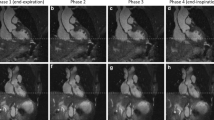Abstract
To evaluate k–t accelerated 3D cine b-SSFP (balanced steady state free precession) as magnetic resonance imaging (MRI) technique for aortic annular area measurement in transcatheter aortic valve replacement (TAVR) planning compared to computed tomography angiography (CTA) and other non-contrast MRI sequences with reduced imaging time and without contrast administration. 6 volunteers and 7 TAVR candidates were prospectively enrolled. The volunteers underwent an MRI while TAVR candidates underwent an MRI and CTA. The following non-contrast MRI sequences were obtained at the level of the aortic root: 2D cine b-SSFP [GRAPPA (GeneRalized Autocalibrating Partially Parallel Acquisitions), R = 2], 3D cine b-SSFP [GRAPPA R = 2], navigator triggered 3D b-SSFP MRA [GRAPPA, R = 2] and k–t accelerated 3D cine b-SSFP [PEAK GRAPPA, R = 5]. Qualitative analysis and aortic annular area measurements in systole and diastole were obtained. k–t accelerated 3D cine b-SSFP provided image quality that is acceptable for confident diagnosis with very good interrater agreement. There was no statistically significant difference in aortic annular measurements between k–t accelerated 3D cine b-SSFP and CTA or other MRI sequences (p > 0.05). Bland–Altman analysis showed no systemic difference of annular area measurements between k–t accelerated 3D cine b-SSFP and each of the other techniques. There was excellent inter-rater agreement on aortic annular area measurements during systolic (ICC = 0.976, p < 0.001) and diastolic (ICC = 0.971, p < 0.001) phases using k–t accelerated 3D cine b-SSFP. K–t accelerated 3D cine b-SSFP is a promising alternative for the assessment of annular sizing in pre-TAVR evaluation while offering a reasonable combination of imaging parameters during one breath-hold.







Similar content being viewed by others
References
La Manna A, Sanfilippo A, Capodanno D, Salemi A, Polizzi G, Deste W et al (2011) Cardiovascular magnetic resonance for the assessment of patients undergoing transcatheter aortic valve implantation: a pilot study. J Cardiovasc Magn Reson 13:82
Paelink BP, Van Herck PL, Rodrigus I, Claeys MJ, Laborde J-C, Parizel PM (2011) Comparison of magnetic resonance imaging of aortic valve stenosis and aortic root to multimodality imaging for selection of transcatheter aortic valve implantation candidates. Am J Cardiol 108:92–98
Jabbour A, Ismail TF, Moat N, Gulati A, Roussin I, Alprendurada F et al (2011) Multimodality imaging in transcatheter aortic valve implantation and post-procedural aortic regurgitation comparison among cardiovascular magnetic resonance, cardiac computed tomography, and echocardiography. J Am Coll Cardiol 58(21):2165–2173
Cannaò PM, Muscogiuri G, Schoepf UJ, De Cecco CN, Suranyi P, Lesslie VW et al (2017) Technical feasibility of a combined noncontrast magnetic resonance protocol for preoperative transcatheter aortic valve replacement evaluation. J Thoracic Imaging 00:1–8
Ruile P, Blanke P, Krauss T, Dorfs S, Jung B, Jander N (2016) Pre-procedural assessment of aortic annulus dimensions for transcatheter aortic valve replacement: comparison of a non-contrast 3D MRA protocol with contrast-enhanced cardiac dual-source CT angiography. Eur Heart J Cardiovasc Imaging 17:458–466
Koos R, Altiok E, Mahnken AH, Neizel M, Dohmen G, Marx N et al (2012) Evaluation of aortic root for definition of prosthesis size by magnetic resonance imaging and cardiac computed tomography: implications for transcatheter aortic valve implantation. Int J Cardiol 158:353–358
Gopal A, Grayburn PA, Mack M, Chacon I, Kim R, Montenegro D et al (2015) Noncontrast 3D CMR imaging for aortic valve annulus sizing in TAVR. JACC Cardiovasc Imaging 8:375–378
Renker M, Varga-Szemes A, Schoepf UJ, Baumann S, Piccini D, Zenge MO et al (2016) A non-contrast self-navigated 3-dimensional MR technique for aortic root and vascular access route assessment in the context of transcatheter aortic valve replacement: proof of concept. Eur Radiol 26:951–958
Jung B, Ullmann P, Honal M, Bauer S, Hennig J, Markl M (2008) Parallel MRI with extended and averaged GRAPPA Kernels (PEAK-GRAPPA): optimized spatiotemporal dynamic imaging. J Magn Reson Imaging 28:1226–1232
Huang F, Akao J, Vijayakumar S, Duensing GR, Limkeman M (2005) K-t GRAPPA: A k-space Implementation for dynamic MRI with high reduction factor. Magn Reson Med 54:1172–1184
Scheffler K, Lehnhardt S (2003) Principles and applications of balanced SSFP techniques. Eur Radiol 13:2409–2418
Markl M, Leupold J (2012) Gradient echo imaging. J Magn Reson Imaging 35:1274–1289
Griswold MA, Jakob PM, Heidemann RM, Nittka M, Jellus V, Wang J, Kiefer B, Haase A (2002) Generalized autocalibrating partially parallel acquisitions (GRAPPA). Magn Reson Med 47:1202–1210
Schnell S, Markl M, Entezari P, Mahadewia RJ, Semaan E, Stankovic Z et al (2014) K-t GRAPPA accelerated four-dimensional flow MRI in the aorta: effect on scan time, image quality, and quantification of flow and wall shear stress. Magn Reson Med 72:522–533
Bollache E, Barker AJ, Dolan RS, Carr JC, Ooij PV, Ahmadian R (2018) k-t accelerated aortic 4D flow MRI in under two minutes: Feasibility and impact of resolution, k-space sampling patterns, and respiratory navigator gating on hemodynamic measurements. Magn Reson Med 79:195–207
Funding
This work was supported by the National Institute of Health [Grant Numbers NHLBI T32 HL134633].
Author information
Authors and Affiliations
Corresponding author
Ethics declarations
Conflict of interest
The authors declare that they have no conflict of interest.
Ethics approval
This study has been performed in accordance with the local ethics committee.
Informed consent
Informed consent was obtained from each subject prior to the investigation in accordance with local ethics committee requirements.
Rights and permissions
About this article
Cite this article
Aouad, P., Jarvis, K.B., Botelho, M.F. et al. Aortic annular dimensions by non-contrast MRI using k–t accelerated 3D cine b-SSFP in pre-procedural assessment for transcatheter aortic valve implantation: a technical feasibility study. Int J Cardiovasc Imaging 37, 651–661 (2021). https://doi.org/10.1007/s10554-020-02038-6
Received:
Accepted:
Published:
Issue Date:
DOI: https://doi.org/10.1007/s10554-020-02038-6




